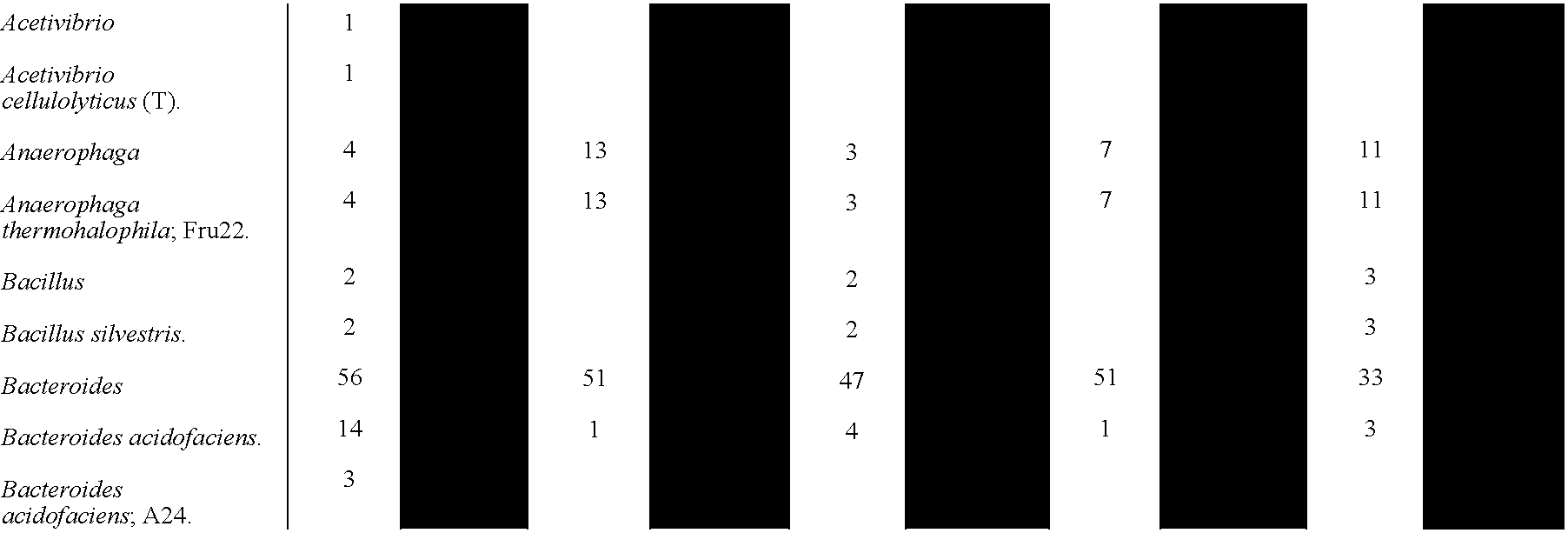Modulation of fiaf and the gastrointestinal microbiota as a means to control energy storage in a subject
a technology of gastrointestinal microbiota and energy storage, which is applied in the direction of peptide/protein ingredients, metabolism disorders, extracellular fluid disorders, etc., can solve the problems of subject to store body fat, and the role of gastrointestinal microbiota in this process has not been demonstrated
- Summary
- Abstract
- Description
- Claims
- Application Information
AI Technical Summary
Benefits of technology
Problems solved by technology
Method used
Image
Examples
examples
[0177] The following examples illustrate the invention.
[0178] Part I. Examples 1-4 correspond to section I of the detailed description. EXAMPLE 1
[0179] Age-matched groups of 7-15 week-old germ-free NMRI / KI mice were maintained in plastic gnotobiotic isolators on a 12 hour light cycle, and given free access to an autoclaved chow diet (B&K Universal). Males were inoculated with wild-type B. thetaiotaomicron (strain VPI-5482) (L. Hooper, et al. (1999) supra). Mice were sacrificed 10 days later, 2 hours after lights were turned on. The distal 1 cm of the small intestine was used to define the number of colony forming units per ml of extruded luminal contents.
[0180] Ileal RNA was isolated from mice with >107 colony forming units (CFU) of bacteria per ml of luminal contents. [Earlier studies had shown that 10 days was sufficient to produce robust colonization of the ileum and that =107 CFU / ml were necessary for full induction of fucosylated glycan production in the ileal epithelium (L....
example 2
[0191] In a further analysis two techniques were combined. First, laser-capture microdissection (LCM) was used to recover three cell populations from frozen sections of ileum harvested immediately after sacrifice of germ-free and colonized mice. The three populations are (i) epithelium present in crypts (the proliferative compartment of the intestine containing undifferentiated cells as well as differentiated members of the Paneth cell lineage); (ii) epithelium overlying villi (containing post-mitotic, differentiated members of the intestine's other three lineages); and (iii) mesenchyme underlying crypt-villus units (FIG. 1).
[0192] LCM was performed on groups of mice independent of those used to generate RNA for the microarray analysis. 7 μm-thick sections were cut from frozen ileums and LCM conducted using the PixCell II system from Arcturus (7.5 μm diameter laser spot). RNA was prepared from dissected cell populations using the RNA Micro-Isolation Kit (Strategene) and standard hi...
example 3
[0203] The concept that microbes such as B. thetaiotaomicron may help legislate changes in expression of a given gene in the intestine, raises the question of whether some or many components of the microbiota can elicit these changes.
[0204] In order to examine this, age-matched groups (n=4-8 mice / group) of 7-15 week-old germ-free NMR1 / KI mice were maintained in plastic gnotobiotic isolators on a 12 hour light cycle, and given free access to an autoclaved chow diet (B&K Universal). Males were inoculated with one of the following groups.
[0205] (i) Nothing--Germ-free control,
[0206] (ii) B. thetaiotaomicron strain VPI-5482 (L. V. Hooper, et al., Proc. Natl, Acad. Sci. U.S.A. 96.9833 (1999)).
[0207] (iii) E. coli K12 which was originally recovered from a normal human fecal flora,
[0208] (iv) Bifidobacterium infantis (ATCC 15697), a prominent component of the pre-weaning human and mouse ileal flora and a commonly used probiotic.
[0209] (v) a ‘complete’ ileal / cecal microbiota harvested ...
PUM
| Property | Measurement | Unit |
|---|---|---|
| Time | aaaaa | aaaaa |
| Angle | aaaaa | aaaaa |
| Electric charge | aaaaa | aaaaa |
Abstract
Description
Claims
Application Information
 Login to View More
Login to View More - R&D
- Intellectual Property
- Life Sciences
- Materials
- Tech Scout
- Unparalleled Data Quality
- Higher Quality Content
- 60% Fewer Hallucinations
Browse by: Latest US Patents, China's latest patents, Technical Efficacy Thesaurus, Application Domain, Technology Topic, Popular Technical Reports.
© 2025 PatSnap. All rights reserved.Legal|Privacy policy|Modern Slavery Act Transparency Statement|Sitemap|About US| Contact US: help@patsnap.com



